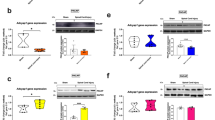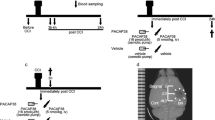Abstract
Pituitary adenylate cyclase-activating polypeptide (PACAP) is a neuroprotective peptide expressed in the central nervous system. To date, changes in the expression and effect of endogenous PACAP have not been clarified with respect to spinal cord injury (SCI). The aim of this study was to elucidate the expression pattern and function of endogenous PACAP on the contusion model of SCI using heterozygous PACAP knockout (PACAP+/−) and wild-type mice. Real-time polymerase chain reaction methods revealed that the level of PACAP mRNA increased gradually for 14 days after SCI and that PAC1R mRNA levels also increased for 7 days compared with intact control mice. PACAP and PAC1R immunoreactivities colabeled with a neuronal marker in the intact spinal cord. Seven days after SCI, PAC1R immunoreactivity was additionally co-expressed with an astrocyte marker. Wild-type mice gradually recovered motor function after 14 days, but PACAP+/− mice showed significantly impaired recovery from 3 days compared with wild-type mice. The injury volume at day 7 in PACAP+/− mice, and the number of single-stranded DNA-immunopositive cells as a marker of neuronal cell death at day 3 were significantly higher than values measured in wild-type mice. These data suggest that endogenous PACAP is upregulated by SCI and has a neuroprotective effect on the damaged spinal cord.








Similar content being viewed by others
References
Alexanian AR, Fehlings MG, Zhang Z, Maiman DJ (2011) Transplanted neutrally modified bone marrow-derived mesenchymal stem cells promote tissue protection and locomotor recovery in spinal cord injuredrats. Neurorehabil Neural Repair 25:873–880
Arimura A, Shioda S (1995) Pituitary adenylate cyclase activating polypeptide (PACAP) and its receptors: neuroendocrine and endocrine interaction. Front Neuroendocrinol 16:53–88
Arimura A, Somogyvari-Vigh A, Miyata A, Mizuno K, Coy DH, Kitada C (1991) Tissue distribution of PACAP as determined by RIA: highly abundant in the rat brain and testes. Endocrinology 129:2787–2789
Basso DM, Fisher LC, Anderson AJ, Jakeman LB, Mctigue DM, Popovich PG (2006) Basso mouse scale for locomotion detects differences in recovery after spinal cord injury in five common mouse strains. J Neurotrauma 23:635–659
Basso DM, Beattie MS, Bresnahan JC (1995) A sensitive and reliable locomotor rating scale for open field score in rats. J Neurotrauma 12:1–21
Benveniste H, Drejer J, Schousboe A, Diemer NH (1984) Elevation of the extracellular concentration of glutamate and aspartate in rat hippocampus during transient cerebral ischemia monitored by intracerebral microdialysis. J Neurochem 43:1369–1374
Bracken MB (2012) Steroids for acute spinal cord injury. Cochrane Detabase Syst Rev 18:CD001046
Chen WH, Tzeng SF (2005) Pituitary adenylate cyclase-activating polypeptide prevents cell death in the spinal cord with traumatic injury. Neurosci Lett 384:117–121
Choi DW, Rothman SM (1990) The role of glutamate neurotoxicity in hopoxic-ischemic neuronal death. Annu Rev Neurosci 13:171–182
Das AK, Gopurappilly R, Parhar I (2011) Current status and prospective application of stem cell-based therapies for spinal cord injury. Curr Stem Cell Res Ther 6:93–104
Dohi K, Mizushima H, Nakajo S et al (2002) Pituitary adenylate cyclase-activating polypeptide (PACAP) prevents hippocampal neurons from apoptosis by inhibiting JNK/SAPK and p38 signal transduction pathways. Regul Pept 109:83–88
Endo K, Nakamachi T, Seki T et al (2011) Neuroprotective effect of PACAP against NMDA-induced retinal damage in the mouse. J Mol Neurosci 43:22–29
Fang KM, Chen JK, Hung SC et al (2010) Effects of combinatorial treatment with pituitary adenylate cyclase activating peptide and human mesenchymal stem cells on spinal cord tissue repair. PLoS One 5:e15299
Farkas O, Tamas A, Zsombok A, Reglodi D et al (2004) Effect of pituitary adenylate cyclase activating polypeptide in the rat model of traumatic brain injury. Regul Pept 123:69–75
Ghatei MA, Takahashi K, Suzuki Y, Gardiner J, Jones PM, Bloom SR (1993) Distribution, molecular characterization of pituitary adenylate cyclase-activating polypeptide and its precursor encoding messenger RNA in human and rat tissues. J Endocrinol 136:159–166
Hashimoto H, Shintani N, Tanaka K et al (2001) Altered psychomotor behaviors in mice lacking pituitary adenylate cyclase-activating polypeptide (PACAP). Proc Natl Acad Sci USA 98:13355–13360
Hashimoto H, Shintani N, Tanida M, Hayata A, Hashimoto R, Baba A (2011) PACAP is implicated in the stress axes. Curr Pharm Des 17:985–989
Jongsma H, Danielsen N, Sundler F, Kanje M (2000) Alteration of PACAP distribution and PACAP receptor binding in the rat sensory nervous system following sciatic nerve transection. Brain Res 853:186–196
Kim WK, Kan Y, Ganea D, Hart RP, Gozes I, Jonakait GM (2000) Vasoactive intestinal peptide and pituitary adenylyl cyclase-activating polypeptide inhibit tumor necrosis factor-alpha production in injured spinal cord and in activated microglia via a cAMP-dependent pathway. J Neurosci 20:3622–3630
Kovesdi E, Tamas A, Reglodi D et al (2008) Posttraumatic administration of pituitary adenylate cyclase activating polypeptide in central fluid percussion injury in rats. Neurotox Res 13:71–78
Ma M, Basso DM, Walters P, Stokes BT, Jakeman LB (2001) Behavioral and histological outcomes following graded spinal cord contusion injury in the C57Bl/6 mouse. Exp Neurol 169:239–254
Masmoudi-Kouki O, Douiri S, Hamdi Y et al (2011) Pituitary adenylate cyclase-activating polypeptide protects astroglial cells against oxidative stress-induced apotosis. J Neurochem 117:403–411
Masmoudi-Kouki O, Gandolfo P, Castel H et al (2007) Role of PACAP and VIP in astroglial functions. Peptides 28:1753–1760
Miyata A, Arimura A, Dahl RR et al (1989) Isolation of a novel 38 residue-hypothalamic polypeptide which stimulates adenylate cyclase in pituitary cells. Biochem Biophys Res Commun 164:567–574
Moller K, Zhang YZ, Hakanson R et al (1993) Pituitary adenylate cyclase activating peptide is a sensory neuropeptide: immunocytocheminal and immunochemical evidence. Neuroscience 57:725–732
Morino T, Ogata T, Horiuchi H et al (2003) Delayed neuronal damage related to microglia proliferation after mild spinal cord compression injury. Neuroscience Res 46:309–318
Nakamachi T, Farkas J, Watanabe J et al (2011a) Role of PACAP in neural stem/progenitor cell and astrocyte—form neural development to neural repair. Curr Pharm Des 17:973–984
Nakamachi T, Li M, Shioda S, Arimura A (2006) Signaling involved in pituitary adenylate cyclase-activating polypeptide-stimulated ADNP expression. Peptides 27:1859–1864
Nakamachi T, Nakamura K, Oshida K et al (2011b) Pituitary adenylate cyclase-activating polypeptide (PACAP) stimulates proliferation of reactive astrocytes in vitro. J Mol Neurosci 43:16–21
Nakamachi T, Ohtaki H, Yofu S et al (2010) Endogenous pituitary adenylate cyclase activating polypeptide is involved in suppression of edema in the ischemic brain. Acta Neurochir Suppl 106:43–46
Ohtaki H, Nakamachi T, Dohi K et al (2006) Pituitary adenylate cyclase-activating polypeptide (PACAP) decreases ischemic neuronal cell death in association with IL-6. Proc Natl Acad Sci USA 103:7488–7493
Ohtaki H, Nakamachi T, Dohi K, Shioda S (2008) Role of PACAP in ischemic neural death. J Mol Neurosci 36:16–25
Okada S, Nakamura M, Katoh H et al (2006) Conditional ablation of Stat3 or Socs3 discloses a dual role for reactive astrocytes after spinal cord injury. Nat Med 12:829–834
Pettersson LM, Heine T, Verge VM, Sundler F, Danielsen N (2004) PACAP mRNA is expressed in rat spinal cord neurons. J Comp Neurol 471:85–96
Seaborn T, Masmoudi-Kouki O, Fournier A, Vaudry H, Vaudry D (2011) Protective effect of pituitary adenylate cyclase-activating polypeptide (PACAP) against apoptosis. Curr Pharm Des 17:204–214
Sherwood NM, Krueckl SL, McRory JE (2000) The origin and function of the pituitary adenylate cyclase-activating polypeptide (PACAP)/glucagon superfamily. Endocr Rev 21:619–670
Shioda S, Ohtaki H, Nakamachi T et al (2006) Pleiotropiv functions of PACAP in the CNS: neuroprotection and neurodevelopment. Ann N Y Acad Sci 1070:550–560
Skoglosa Y, Lewen A, Takei N, Hillered L, Lindholm D (1999) Regulation of pituitary adenylate cyclase activating polypeptide and its receptor type 1 after traumatic brain injury: comparison with brain-derived neurotrophic factor and the induction of neuronal cell death. Neurosci 90:235–247
Somogyvari-Vigh A, Reglodi D (2004) Pituitary adenylate cyclase activating polypeptide: a potential neuroprotective peptide. Curr Pharm Des 10:2861–2889
Stumm R, Kolodziej A, Prinz V, Endres M, Wu DF, Hollt V (2007) Pituitary adenylate cyclase-activating polypeptide is up-regulated in cortical pyramidal cells after focal ischemia and protects neurons from mild hypoxic/ischemic damage. J Neurochem 103:1666–1681
Suarez V, Guntinas-Lichius O, Streppel M et al (2006) The axotomy-induced neuropeptides galanin and pituitary adenylate cyclase-activating peptide promote axonal sprouting of primary afferent and cranial motor neurons. Eur J Neurosci 24:1555–1564
Suzuki R, Arata S, Nakajo S et al (2003) Expression of the receptor for pituitary adenylate cyclaseactivating polypeptide (PAC1-R) in reactive astrocytes. Brain Res Mol Brain Res 115:10–20
Szabadfi K, Atlasz T, Kiss P et al (2012) Mice defidient in pituitary adenylate cyclase activating polypeptide (PACAP) are more susceptible to retinal ischemic injury in vivo. Neurotox Res 21:41–48
Tamas A, Zsombok A, Farkas O et al (2006) Postinjury administration of pituitary adenylate cyclase activating polypeptide (PACAP) attenuates traumatically induced axonal injury in rats. J Neurotrauma 23:686–695
Vaudry D, Falluel-More A, Bourgault S et al (2009) Pituitary adenylate cyclase-activating polypeptide and its receptors: 20 years after the discovery. Pharmacol Rev 61:283–357
Vaudry D, Hamelink C, Damadzic R, Eskay RL, Gonzalez B, Eiden LE (2005) Endogenous PACAP acts as a stress response peptide to protect cerebellar neurons from ethanol or oxidative insult. Peptides 26:2518–2524
van Landeghem FK, Weiss T, Oehmichen M, von Deimling A (2007) Cellular localization of pituitary adenylate cyclase-activating peptide (PACAP) following traumatic brain injury in humans. Acta neuropathol 113:683–693
Zhang Q, Shi TJ, Ji RR et al (1995) Expression of pituitary adenylate cyclase-activating polypeptide in dorsal root ganglia following axotomy: time course and coexistence. Brain Res 705:149–158
Acknowledgments
This work was supported in part by a Grant-in-Aid for Scientific Research (TN, SS) and by a High-Technology Research Center Project (SS) from the Ministry of Education, Science, Sports and Culture of Japan, and Research on Health Sciences focusing on Drug Innovation from The Japan Health Sciences Foundation (SS) and Support Program for the Strategic Research Foundation at Showa University, 2008-2012.
Author information
Authors and Affiliations
Corresponding author
Rights and permissions
About this article
Cite this article
Tsuchikawa, D., Nakamachi, T., Tsuchida, M. et al. Neuroprotective Effect of Endogenous Pituitary Adenylate Cyclase-Activating Polypeptide on Spinal Cord Injury. J Mol Neurosci 48, 508–517 (2012). https://doi.org/10.1007/s12031-012-9817-2
Received:
Accepted:
Published:
Issue Date:
DOI: https://doi.org/10.1007/s12031-012-9817-2




